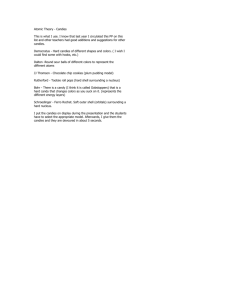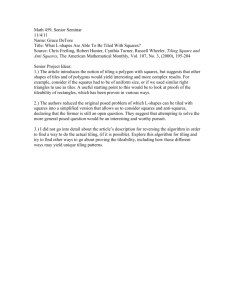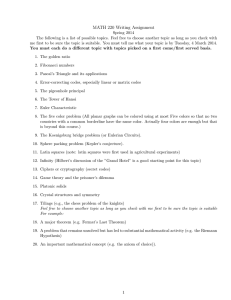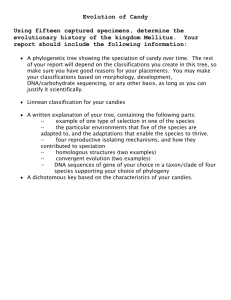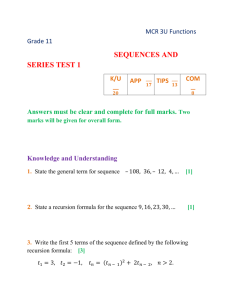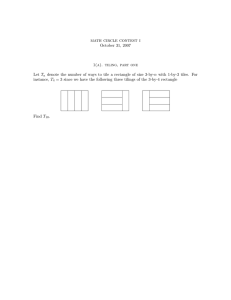Kate’s problem: The students are distributed around a circular table.... candies to all the students, so that each student has...
advertisement
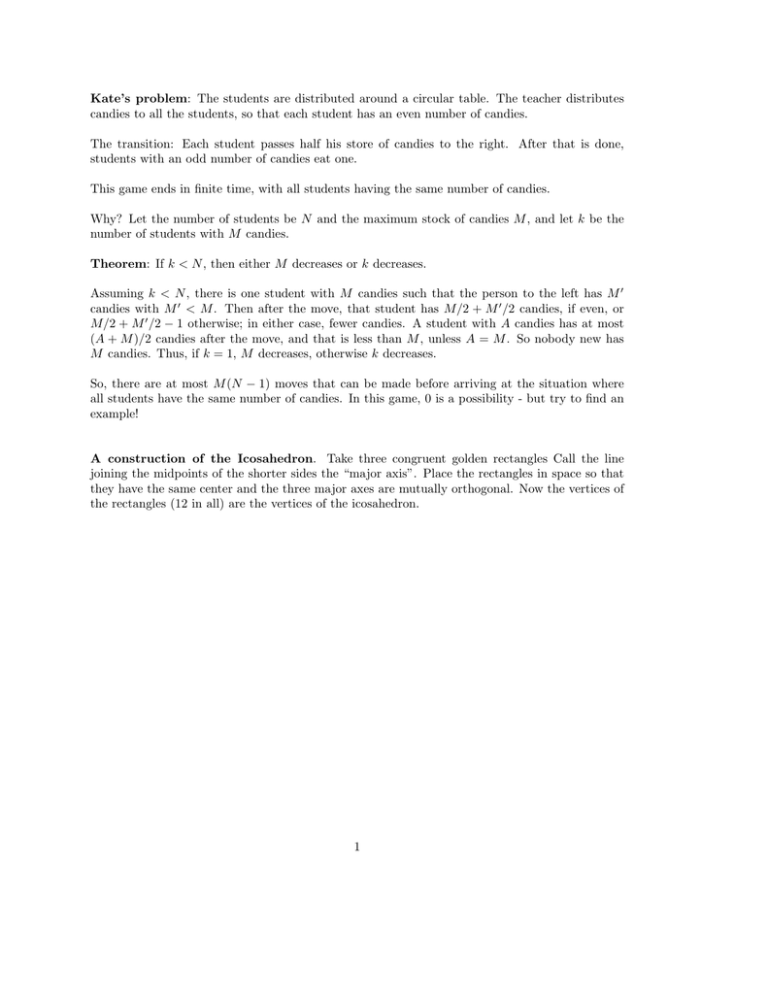
Kate’s problem: The students are distributed around a circular table. The teacher distributes
candies to all the students, so that each student has an even number of candies.
The transition: Each student passes half his store of candies to the right. After that is done,
students with an odd number of candies eat one.
This game ends in finite time, with all students having the same number of candies.
Why? Let the number of students be N and the maximum stock of candies M , and let k be the
number of students with M candies.
Theorem: If k < N , then either M decreases or k decreases.
Assuming k < N , there is one student with M candies such that the person to the left has M 0
candies with M 0 < M . Then after the move, that student has M/2 + M 0 /2 candies, if even, or
M/2 + M 0 /2 − 1 otherwise; in either case, fewer candies. A student with A candies has at most
(A + M )/2 candies after the move, and that is less than M , unless A = M . So nobody new has
M candies. Thus, if k = 1, M decreases, otherwise k decreases.
So, there are at most M (N − 1) moves that can be made before arriving at the situation where
all students have the same number of candies. In this game, 0 is a possibility - but try to find an
example!
A construction of the Icosahedron. Take three congruent golden rectangles Call the line
joining the midpoints of the shorter sides the “major axis”. Place the rectangles in space so that
they have the same center and the three major axes are mutually orthogonal. Now the vertices of
the rectangles (12 in all) are the vertices of the icosahedron.
1
A Way of Looking at Fibonacci Numbers
Utah Teachers’ Circle, September 24, 2007
A recursive algorithm is a procedure determined by two parts:
A. An initial position;
B. A rule for getting from one position to the next.
Example:
A. Start at 1;
B. Given a number, add 1.
It is plain to see that this gives us the counting numbers 1, 2, 3, . . . as far as we want to go. We
can say that, for this algorithm the nth output is n.
Another example:
A. Start at 1;
B. At the nth step, add n.
Here, the nth number is 1 + 2 + 3 + · · · + n. Can you show that this is 21 n(n + 1)?
Let an be the nth number. Draw a square (n + 1) × (n + 1) array of small squares. There are n + 1
squares on the diagonal, an square both above and below the diagonal. Thus
(n + 1)2 = an + (n + 1) + an ,
hence the result. Or, proceed by induction which works since
1
1
(n − 1)(n) + n = n(n + 1) .
2
2
Another example:
A. Start at 1;
B. At the nth step, multipy by n.
Here, the nth number is n!, which of course is a symbol for what we have just done; the only way
to calculate n! is to multiply the result at hand by the next integer.
More examples:
(A)
a0 , a1
any two numbers ; an = (an−1 + an−2 )/2 ;
2
Here the sequence is clearly bounded; in fact each term is between its two predecessors. This
suggests convergence. Assuming convergence, can you find the limit?
Here’s the trick: Find an r such that the sequence rn satisfies the recursion relation:
r2 =
which has the roots
1
(r + 1) ,
2
√
1± 8
1
r=
= 1, − .
4
2
So the sequences {1, 1, 1, . . . and −.5, +.25, −.125, . . . , (−.5)n , . . . both satisfy the recursion relation.
So does any linear combination of these. So find coefficients α, β such that
1
a0 = α + β( )0 ,
2
1
a1 = α + β( )1 .
2
We get this closed form:
an =
2
1
a0 + 2a1
+ (a0 − a1 )(− )n .
3
3
2
which clearly converges to (a0 + 2a1 )/3.
(B)
a0
any number ;
an = 1 +
1
an−1
.
We’ll return to this sequence later. In the meantime, think about what its limit can be.
Now, let’s start a new idea. Consider a line of n squares and piles of two types of tiles: 1-tiles
are squares the size of the squares forming the line, and 2-tiles are two such squares with a common
side.
Question: In how many ways can the line be covered by such tiles?
3
Let fn be the number of ways to cover a line of length n. We can calculate the first few values of
fn .
f1 = 1, obviously.
f2 = 2: we can cover with two 1-tiles or 1 2-tiles.
f3 = 3: there is one way using no 2-tiles, and two ways using 1 2-tile.
f4 = 5: no 2-tiles: 1 way; one 2-tile: 3 ways; two 2-tiles: 1 way.
And so forth : f5 = 8, f6 = 13, . . ..
Can you verify a recursion relation for this sequence?
Identity 1
f1 = 1,
fn = fn−1 + fn−2 .
Given a tiling, it ends in either a 1-tile or a 2-tile. We get fn−1 tilings that end in a 1-tile and
fn−2 tilings that end in a 2-tile.
This is the Fibonacci sequence, and a wonderful way of describing it, leading to relatively easy
combinatorial ways of deriving identities. For example, let’s try to generalize the way we counted
the first few values to get another formula for fn .
Given n, in how many ways can we tile the n-line using i 2-tiles?
Hint: you’ll need to know the combinatorial coefficient “n-choose-m”
n
m
.
Answer: Since each 2 tile covers two squares, the total number of 1-tiles used will be n − 2i, so
the total number of tiles used is n − i. We can then conceive of the line as formed of n − i spaces,
of which i are to filled with 2-tiles and the remainder with 1-tiles. So the answer is the number of
ways to select i spaces from n − i spaces. This is
n−i
(n − i)!
=
i
(n − 2i)!i!
and so we see that
Identity 2
where
···
n
n−1
n−2
n−3
fn =
+
+
+
+ ··· ,
0
1
2
3
means we keep adding terms so long as they make sense (i ≤ n − 1).
Let’s now look for other ways of counting the number of tilings, fn .
For each k, suppose the last 2-tile covers squares k + 1 and k + 2. What identity does this lead to?
We cover the squares up to (and including) the kth square any way we please, but after the k + 2th
square, they are all 1-tiles. Thus there are fk tilings with the last 2-tile in position k + 1; k + 2.
We only go up to fn−2 , and finally there is the tiling with no 2-tiles. Thus
Identity 3
fn = f0 + f1 + f2 + · · · fn−2 + 1 .
4
Now suppose the last 1-tile is in the k + 1 position. There are fk such tilings, since every tile
thereafter is a 2-tile. In particular, we must have n − (k + 1) even, and so we better break this up
into two cases.
n is odd. In this case, since n − (k + 1) must be even, k can only be an even number. Thus
f2n+1 = f0 + f2 + f4 + · · · f2n .
Identity 4
n is even. Then we can only have k odd, and besides there is one tiling with no 1-tiles, so
f2n = f1 + f3 + f5 + · · · f2n−1 + 1 .
Identity 5
Now, put an n-line directly after an m-line and count the m + n tilings where there is a
break at this junction , and those where a 2-tile bridging the two lines. What identity does this
produce?
There are fm fn tiles with a break as described, and fm−1 fn−1 tiles with no break there. Thus
Identity 6
fm+n = fm fn + fm−1 fn−1 .
In particular
2
fn2 = fn2 + fn−1
.
Identity 7
Let’s start again with fm+n , and iterate the recursion relation n times. What do you get?
fm+n = fm+n−1 + fm+n−2
fm+n = fm+n−2 + fm+n−3 + fm+n−3 + fm+n−4
or
fm+n = fm+n−2 + 2fm+n−3 + fm+n−4
fm+n = (fm+n−3 + fm+n−4 ) + 2(fm+n−4 + (fm+n−5 ) + (fm+n−5 + fm+n−6 )
or
fm+n = fm+n−3 + 3fm+n−4 + 3fm+n−5 + fm+n−6 .
If we do this again we start with fm+n−4 , and going down by one, the coefficients will be 1,4,6,4,1.
In other words, the recursion is the same as that for Pascal’s triangle, and in n steps we end up
with
Identity 8
fm+n = fm +1 Cnfm−1 +2 Cnfm−2 +n−1 Cn f1 + f0 .
We return to the sequence defined recursively by
a1 = 1;
an = 1 +
1
an−1
,
and calculate a few values:
1, 2,
3 5 8 13 21 34 55 89
, , ,
,
,
,
,
.
2 3 5 8 13 21 34 55
5
We seem to be getting the quotients of consecutive members of the Fibonacci sequence. Can you
show this, i.e., that
fn
.
an =
fn−1
Show that the quotients of consecutive fibonaccis satisfies the recursion relation and the initial
condition:
fn
fn−1 + fn−2
fn−2
1
=
=1+
=1+
.
fn−1
fn−1
fn−1
fn−1 /fn−2
Now let’s write the sequence in decimal form:
1, 2, 1.5, 1.66667, 1.6, 1.625, 1.61538, 1.61905, 1.61764, 1.61818, 1.61797, 1.61806, 1.61803 .
It looks like the sequence is settling down, somewhere around 1.6180. This suggests two things:
that we show that the sequence actually converges, and find the limit. Assuming the first, can you
find the limit?
Well, we can let n → ∞ in the recursion equation, getting, where a represents the limit,
a=1+
1
.
a
This leads to the quadratic equation a2 − a − 1 = 0 which has the roots
√
1± 5
r=
.
2
Since a ≥ 1 (why?), we must have
√
1+ 5
r=
,
2
which is 1.618033989 . . ..
So, the question remains: why does the sequence converge? That comes out of another identity
that can be proven using the idea of tilings of lines of squares. Let’s take two lines of length n.
Then the number of different ways of tiling the two simultaneously is clearly fn2 . But now, let’s
count that another way. Place the second line just below the first line, but offset by just one square.
Given a tiling of the two together, we’ll say that it has a fault at square k (counting along the top
line) if a new tile starts at square k on both lines.
Now, given a tiling, suppose it has faults and the first one is at square k. Exchange the tails of
the two lines, getting a tiling of two lines, the top one of length n + 1, and the bottom one of
length n − 1. This gives a correspondence of of all tilings-with-faults of two lines of length n with
all tilings-with-faults of two lines of lengths n − 1 and n + 1. Finally, are there any tilings without
faults in either case? We have to consider the even and odd cases separately.
If n is even, it is easy to see that the only no-fault tiling of two n lines (so arranged is that with all
2-tiles. Furthermore, there is no fault-free tiling of the two lines of lengths n − 1 and n + 1. Thus
n
even :
fn2 = fn+1 fn−1 + 1 .
6
In case n is odd, each line must have at least 1 1-tile, from which we can conclude that all tilings
have a fault. However, the two lines of lengths n − 1 and n + 1 have a no-fault tiling with all 2-tiles.
Thus
n odd : fn2 = fn+1 fn−1 − 1 ,
or, put together:
Identity 9
forall n :
fn2 = fn+1 fn−1 + (−1)n .
This then gives us
fn
Identity 10
fn−1
=
fn+1
(−1)n
+
.
fn
fn fn−1
One last point. The equation for this sequence is the same as the one we’d get for the fibonacci
recursion, trying the sequence an = rn . We conclude, in the same way as we did for the sequence
of successive
averages, that the fibonacci sequence has to be a linear combination of the roots
√
r = 1±2 5 . If we fit such a linear combination to the initial values, we obtain
Identity 11
√
√
1 h 1 + 5 n 1 − 5 n i
fn = √
+
.
2
2
5
Art Benjamin’s magic trick: ask the participants to pick two integers and put them in a
column. In the third row, write the sum of the two preceding rows, and continue, up to the tenth
row. Now sum all the rows.
The sum is 11 times the 7th row.
Example
3
7
10
17
27
44
71∗
115
186
301
sum: 781
7
